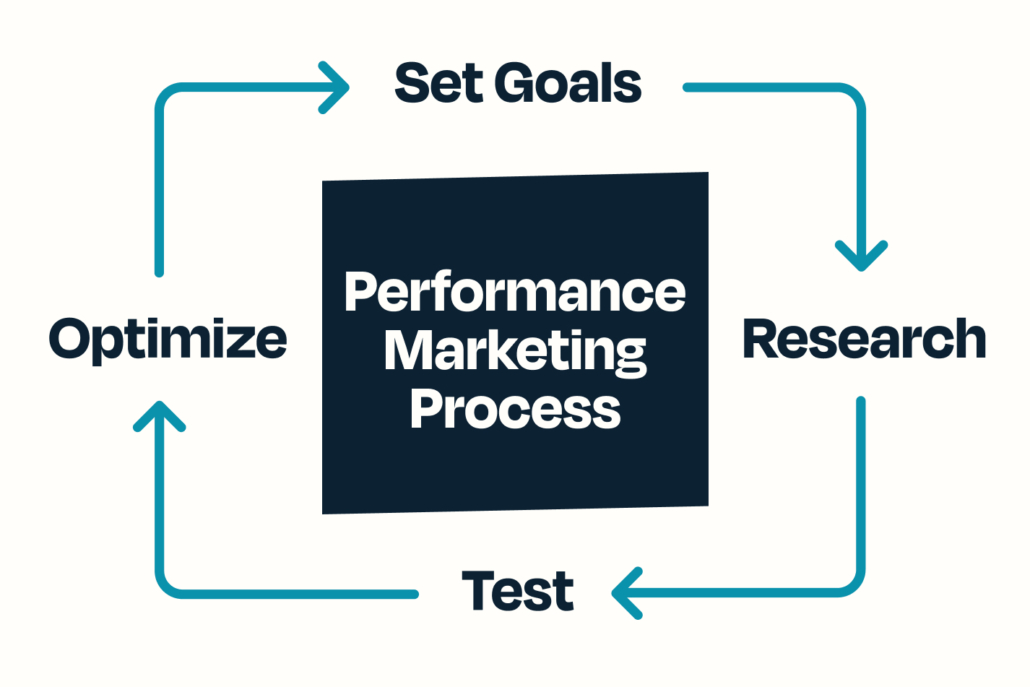The 4 Essential Steps of Performance Marketing for Brands
In working with hundreds of brands — from startup to enterprise — over the last half decade, we’ve found brand growth strategies can usually be distilled into one of three categories:
- Growth at all costs (GAAC)
- Brand to demand marketing
- Performance-based marketing
GAAC, or growth at all costs, was most popular with venture backed startups and scaleups prioritizing new customer acquisition over any other metric (even at a loss). With rising interest rates and inflation, this methodology reduced in popularity in Summer 2022, but still exists in certain subindustries (ecommerce, mostly).
Brand to demand marketers are a new wave of marketers trying to undo the measurement KPIs of performance marketing. They argue that without brand awareness, performance marketing isn’t a viable play. The connection between brand and demand is often a difficult one and dependent on leading metrics above all other considerations.
Finally, there’s performance-based marketing. This is exactly what it sounds like: Marketing that focuses on specific, measurable, business-relevant KPIs. Performance marketers believe every action levels up to what the brand is trying to achieve — namely, grow revenue.
As data collection and analytic methods become increasingly robust, performance marketing is evolving into the leading methodology for digital marketing efforts. So understanding how to speak performance marketing language — and view marketing tactics through a performance lens — is essential for staying at the forefront of the marketing industry.
Below, we’ll break down the four vital components of performance marketing for brands of all sizes.
What is Performance Marketing?
At Tuff, we define performance marketing as a results-driven approach that focuses on a business outcome. Other marketers will define it more loosely—saying that it’s simply attempting to hit a certain measurable KPI, even if that KPI is something fluffy like CTR or CPC.
So, why be so detailed about measurement?
For starters, just about anything is measurable these days. Sure, you might not be able to measure the number of impressions a billboard generates down to the individual consumer. But you can likely do some form of test to measure the impact a billboard has on your sales. (For what it’s worth, we don’t recommend it.) And this is an extreme example by any reasonable standard today. Digital campaigns—across all mediums—offer a level of granular tracking that physical media could never come close to reproducing.
Therein lies the difference: Rather than focusing on any sort of measurable outcome, we’re focusing on measurable growth–most often dolla’, dolla’ bills.
The 4 Steps of Performance Marketing with an Agency
Performance-based marketing, especially when executed by a performance marketing agency, falls into a four-step process: Goal setting, research, testing, and optimization. These four steps are interdependent and iterative, driving continuous growth. Similar to growth, in order for it to be successful, it requires a growth marketing culture and mindset oriented towards achieving results.
-
- Goal Setting: Before you put down any plans, ask yourself what you’re trying to achieve. Then–ask how you could measure it. This will influence every step of the process, because it will make clear what you should prioritize and what you should not.
- Research and Strategy: Let’s say you set a goal of running a marathon. Would you ever try to run a marathon without training? It may work for one in a million, but it’s unlikely to work for most.Without adequate preparation (research), you can’t plan an adequate strategy to accomplish your goals. You’ll waste time and burn valuable resources to teach you things you could have discovered before you’ve spent a dollar on ads–the opposite of a performance-based marketing approach.
- Testing: When ads go live–start small. A good rule of thumb is to allocate spending to a level where your test is significant enough to fail without major repercussions, but large enough to make a measurable impact. Using the marathon analogy, this is a half-marathon, or a 10k warmup as part of your training.
- Optimization and Ongoing: Once you uncover your initial learnings, continue to optimize toward those and expand upon them. Going back to the marathon analogy–once you get a couple of them under your belt, start to work on setting a new personal best. Continue to find areas to grow, revenue to unlock, and efficiencies to gain.
Every step along the way is repeatable–if your test fails, go back to research and strategy! If optimization hits a point of diminishing returns, try adjusting your strategy, or testing new things in incremental ways. That’s what the framework of performance-based marketing is all about.
Paid Strategies for Scaleups in Performance Marketing
There are a few obvious choices for what could be considered a performance-based marketing tactic:
- Paid Search / PPC Advertising
- Retargeting on Paid Social
- Search Engine Optimization
- Email Marketing
- Performance Max (for D2C Brands)
However, there are several lesser-discussed tactics that we believe also qualify as performance-based, (even if others may not), depending on what the ultimate goal is.
Conversion Rate Optimization: Perhaps the most overlooked part of Performance Marketing is tailoring the user journey and experience to a specific conversion action. CRO is the fastest way to unlock exponential growth: A 15% increase in conversion rate via landing page optimizations or personalization can help your media budgets go that much further. Your media dollars are likely heavily scrutinized: it’s time to treat landing pages, web experiences, userflows, and more the same way.
Demand Generation Campaigns: A major reason why the majority of marketers may not immediately define demand generation campaigns as a performance-based approach is the ability to measure results. We disagree. There are several KPIs within a demand generation campaign that can be measured, including content views, content engagement, ICP traffic visits, and most of all—REVENUE.
If someone suggests otherwise, it’s likely because they either haven’t fully explored the capabilities of measurement tools or lack the expertise to effectively implement such campaigns. With the right tools, methodologies, and expertise in place, demand generation campaigns can certainly be executed as performance-driven initiatives, delivering tangible results and driving business growth.
Account-Based Marketing (ABM) Campaigns: Account-based marketing is a B2B-specific strategy in which you target specific accounts (companies) based on varying criteria: industry, revenue, intent, etc.
The ultimate goal of an ABM approach is to win revenue from specific companies–whether that’s by retaining their business or winning new business from them. ABM campaigns can have all sorts of KPIs–everything from closed/won revenue to specific account coverage goals in order to generate heightened levels of awareness.
Youtube Advertising: Youtube’s advertising, and video advertising capabilities in general have greatly improved in the last 18-24 months. In particular, we’ve found that treating Youtube as a complementary channel to paid search is highly effective. You can accomplish this by creating custom audiences of users who search the same target keywords you are bidding on, which can lead to massive gains in efficiencies for both paid search and Youtube.
Youtube can have all sorts of specific goals–everything from conversions, target frequency, etc. that can map back to your business KPIs as a performance-based marketing strategy.
Paid Social Advertising: In the right usage, paid social channels like Meta, TikTok, and LinkedIn can be highly effective performance-based channels–as long as you’re using them for their appropriate audiences. To be performance-based, it’s most helpful to use a conversion-optimized campaign strategy. But if your main KPI is higher-funnel, such as traffic generated, it can also be a complementary channel with the right measurement system to ensure it affects revenue.
These are just a few of the many different performance strategies our performance marketing agency deploys. There are several other strategies that could be considered performance-based that are not primary strategies. For example, programmatic display, content marketing, lead generation strategies, affiliate marketing, so on and so forth. At Tuff, we continuously explore and test new tactics to drive measurable results for our partners.
Is Performance Marketing Right for You?
If you’re not in the “growth at all costs” stage of user acquisition, then performance-based marketing is likely a strategy that can work for your brand. The most important part is that you assemble the right team: Evaluate your team’s internal skill sets and determine if they can approach marketing with a vigorous test-and-learn mindset.
If you’re looking for a performance marketing agency to help you hit your goals–let’s talk.

Richard has spent the last five years working at digital agencies, exploring various industries and company lifecycles. I’ve created and implemented growth campaigns on just about every platform for startups, $20,000,000 a year companies, and everything in-between. When not at work, I can be found cheering on the Penguins or Steelers, spending time with my wife and son, playing disc golf, baking, or walking my dogs.







